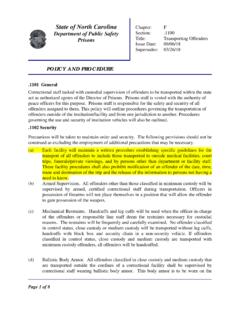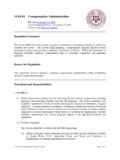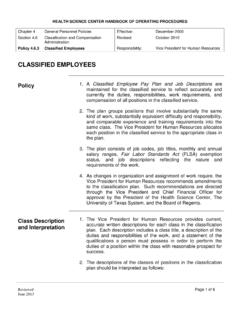Transcription of Establishing a Uniform Policy: Head to toe - aibonline.org
1 10 November/December 2010 AIb UPDATe Establishing a Uniform policy : Head to toeA clear Uniform policy that is adhered to by employees not only prevents product contamination, but also is critical to passing an & ProceduresNovember/December 2010 AIb UPDATe 11By KErry bEach and stEPhaniE loPEzin today s world of documentation and written policies, it is not uncommon to find food plant managers covered in paperwork and overwhelmed by the amount of work required to actually develop effective plant policies that meet their specific needs. One problem that managers face is the lack of guidance and resources available to write effective food plant policies that not only meet regulatory and customer requirements, but also meet their plant s unique important plant policy that applies to every employee and may be difficult to design is the Uniform policy .
2 The GMPs and many food industry standards require that food plant personnel wear clean uniforms or work clothing that are not decorated with items that could easily fall into the product. But, aside from very general requirements ( suitable footwear, clean uniforms, effective hair restraints, no shirt pockets, etc.) there is not a lot of specific direction provided for developing a more detailed policy . This article provides a head-to-toe look at the items that should be considered in a Uniform policy that not only meet industry require-ments, but go above and beyond the basics to ensure that employee uniforms are not a source of food product contamination.
3 The focus is food safety. Employee safety implications must also be considered, but are not fully examined here. Consider these suggestions as they apply to your food facility and examine your Uniform policy to determine if any updates are needed. And keep in mind that a good Uniform policy will address all plant personnel, not just Hat/bump capWhat s the first thought that comes to mind when you see someone wearing a hard hat or bump cap? If it s out of context, then you probably assume that person works in construction or a job where safety is an issue. Many food plant workers, especially maintenance employees, wear hard hats as part of their daily job.
4 When consider-ing whether or not to include this item as part of your employee Uniform , answer a few questions:Is it needed for safety? What positions or departments should wear the hats for protection? Although hard hats are a safety device used to offer head protec-tion, they can also be a hindrance because they can limit vision. This should be considered when selecting the size and style of hard hat to issue employees. Another thing to consider when selecting hard hats is to order a variety of colors. Some plants use a color-coded hat system to identify departments or employee seniority levels. Others may color-code hats by area, such as pre-kill step (red), post-kill step (blue) allergens used (green), and non-allergen area (white).
5 One excellent idea is to have a designated color of hard hat that visitors or contractors wear to easily identify them as addition to employee safety concerns, food safety consider-ations should also be made. The Uniform policy should clearly state the predetermined frequency and necessary procedures as part of Policies & Procedures12 November/December 2010 AIb UPDATe the bump cap/hard hat cleaning program. The policy should also make it clear that hard hats are not to be taken off-site, but must remain in employee lockers or other on-site storage area. Stickers and other adornments should be prohibited, but there is an excellent op-portunity to attach tethered earplugs to the hats, if used at the facility.
6 This will prevent the loss of earplugs in the facility and help your facility avoid instances of product , the policy must clearly establish that bump caps/hard hats are not a substi-tute for hair nets. Effective hair restraint is required beneath the cap (Head coverings for warmth)Employees that work in cold areas of the fa-cility where frozen or refrigerated products are handled or stored will often wear ad-ditional items with the standard employee Uniform , such as knit caps, to keep warm. Sometimes these are company-issued caps; other times facilities may allow employees to wear personal caps.
7 Either way, there are certain food safety considerations to include in the Uniform policy . Each food company should determine if it will require hairnets to be worn in conjunction with these items. Most head coverings for warmth will fully contain hair and therefore hairnets are not required. However, some companies decide that everyone wears a hairnet and require the hairnet to be worn over the knit cap. One thing to consider is that if the knit cap is covered with a hairnet, it is more difficult to identify dirty caps. On that note, the policy should also include that knit caps must be regularly laundered and specify if it will be done by employees, in-house laundry, or a contracted service.
8 The policy should also state that knit caps must be in good condition. Loose threads are an adulteration coversThe AIB Consolidated Standards for Inspec-tion, which are based on the GMPs and common industry expectations, requires that Personnel wear effective hair restraints to fully contain hair, if applicable. Hair restraints include head, beard or moustache covers. (Stnd ) However, it is up to each facility to determine any more specific policy inclusions. It may not seem as if employee safety would be a consideration when determin-ing the type of hairnet to provide employ-ees, however the material is important to consider, especially for those who work in areas where welding takes place.
9 Certain materials may cause a spark hazard. The hairnet material selected is also important to food safety. Some food facilities require fine-mesh hairnets, while others use the bouffant style. Regardless, it is important to realize that wide-mesh hairnets are ineffec-tive at preventing hair from contaminating the food hair cover requirement that all plants agree on is that the items are clean at the beginning of each shift. However, a not-so-clear area of debate is whether employees with shaved heads are required to wear hairnets. This is up to each plant to determine requirements.
10 A shaved head is effective hair restraint and meets AIB and government requirements; however for enforcement purposes, it may be easier to require that all personnel wear to some, a one size fits all approach is not acceptable for hairnets. If the net is too large it won t be tight or contain hair. Conversely, if it is too small, hair will stick out, making it ineffective. Each plant should ensure that the correct sizes are available for all employees. Hair cover color is another consider-ation to address in the Uniform policy . On most people, dark colored hairnets, such as brown and black, make it difficult to determine if they are wearing a hairnet without looking closely.







